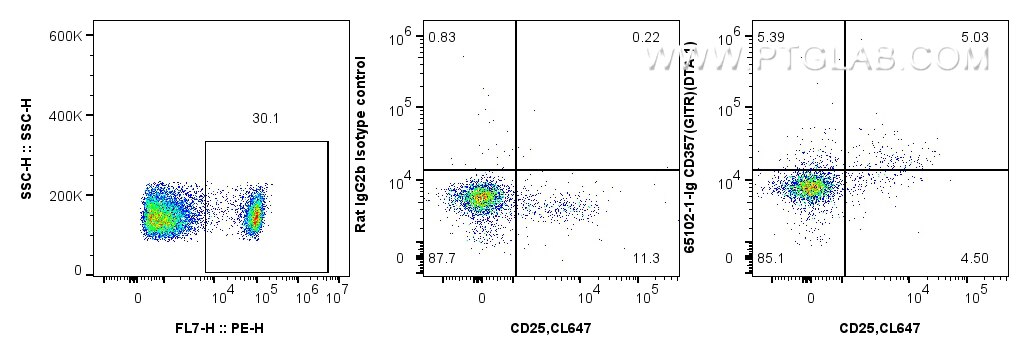GITR/TNFRSF18 Monoklonaler Antikörper
GITR/TNFRSF18 Monoklonal Antikörper für FC
Wirt / Isotyp
Ratte / IgG2b, kappa
Getestete Reaktivität
Maus
Anwendung
FC
Konjugation
Unkonjugiert
CloneNo.
DTA-1
Kat-Nr. : 65102-1-Ig
Synonyme
Geprüfte Anwendungen
| Erfolgreiche Detektion in FC | Maus-Splenozyten |
Empfohlene Verdünnung
| Anwendung | Verdünnung |
|---|---|
| This reagent has been tested for flow cytometric analysis. It is recommended that this reagent should be titrated in each testing system to obtain optimal results. | |
| Sample-dependent, check data in validation data gallery | |
Produktinformation
65102-1-Ig bindet in FC GITR/TNFRSF18 und zeigt Reaktivität mit Maus
| Getestete Reaktivität | Maus |
| Wirt / Isotyp | Ratte / IgG2b, kappa |
| Klonalität | Monoklonal |
| Typ | Antikörper |
| Immunogen | Maus-CD25+-CD4+-T-Zellen |
| Vollständiger Name | tumor necrosis factor receptor superfamily, member 18 |
| GenBank-Zugangsnummer | BC146517 |
| Gene symbol | CD357 |
| Gene ID (NCBI) | 21936 |
| Konjugation | Unkonjugiert |
| Form | Liquid |
| Reinigungsmethode | Affinitätsreinigung |
| Lagerungspuffer | PBS with 0.09% sodium azide |
| Lagerungsbedingungen | Store at 2-8°C. Stable for one year after shipment. |
Hintergrundinformationen
Glucocorticoid-induced TNFR-related protein (GITR), also known as CD357 or TNFRSF18, is a member of the tumor necrosis factor receptor (TNF-R) superfamily. GITR is expressed constitutively at high levels in T regulatory cells (Treg cells) and plays a key role in dominant immunological self-tolerance maintained by CD25+CD4+ regulatory T cells (PMID: 11812990). It is expressed at low levels on resting responder T cells. The expression of GITR on T cells can be upregulated upon activation (PMID: 15770698). GITR is activated by GITR ligand (GITRL) which is mainly expressed on APC. GITR-GITRL interactions could co-stimulate both responder T-cell functions and the suppressive functions of Treg cells (PMID: 16868552).
Protokolle
| PRODUKTSPEZIFISCHE PROTOKOLLE | |
|---|---|
| FC protocol for GITR/TNFRSF18 antibody 65102-1-Ig | Download protocol |
| STANDARD-PROTOKOLLE | |
|---|---|
| Klicken Sie hier, um unsere Standardprotokolle anzuzeigen |


